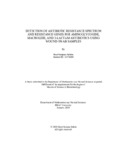Isolation of Acinetobacter baumannii from patient and hospital environment: analyzing their antibiotic resistance, serum resistance & biofilm formation
Abstract
The Acinetobacter baumannii is a gram-negative coccobacillus also known as opportunistic
bacterial pathogens currently creating great concern in clinical aspects due to their capacity to
endure for extended periods of time in the environment and ability to cause multi-drug
resistant infections. The objective of the study was to identify A. baumannii from hospital
environments and admitted patients in hospital to analyze their antibiotic resistance, serum
resistance and biofilm formation. Total 450 samples were collected from different wards of
Rajshahi Medical College and Hospital. Among them we obtained 53 isolates of A. baumannii
confirmed by polymerase chain reaction by targeting of the blaOXA-51 gene. From 53
isolates, 20 were from patient’s samples (7 endotracheal aspirates, 4 blood, 5 wound swab, 2
throat swab and 2 catheter tube ) and 33 isolates were from environment’s samples (bed sheet,
surface of furniture, nebulizer machine, floor, nurse’s hand swab, food cart, medicine cart and
trolleys). Subsequently, an antibiotic susceptibility test was done. Isolates from patient
specimens were resistant to gentamicin (90%), amikacin (90%), cefepime,
piperacillin-tazobactam (85%), ceftazidime(85%), and tetracycline (80%). A significant
proportion of the isolates, 70%, displayed resistant against levofloxacin, imipenem,
meropenem. Most importantly, 90% of all patient isolates were MDR. On the other hand,
hospital environment’s isolates were resistant against ceftazidime(100%), imipenem(87.9%,),
piperacillin-tazobactam (78.8%), and cefepime(78.8%). A significant proportion of the
isolates, 69.7% and 66.7% were resistant against meropenem and gentamicin. Among them
80% of all isolates were MDR. The result of the serum bactericidal assay showed that almost
31% of isolates were serum resistant and 35% were sensitive and 34% were intermediate.
Isolates from the environment's samples were 10% more resistant than the isolates from the
patient's samples. Among environment’s isolates 36% isolates were resistant whereas among
patient’s isolates only 26% were resistant. According to quantitative biofilm formation
results, among 33 environmental isolates 17% of isolates formed strong biofilm, 14% formed
moderate film, and 30% formed weak and 39% isolates did not form biofilm.
Keywords
Acinetobacter baumannii; Multi-drug resistance; Antibiotic resistance; Serum resistance; Biofilm formationDescription
This thesis is submitted in partial fulfillment of the requirements for the degree of Bachelor of Science in Microbiology, 2024.Department
Department of Mathematics and Natural Sciences, BRAC UniversityType
ThesisCollections
Related items
Showing items related by title, author, creator and subject.
-
Detection of antibiotic resistance spectrum and resistance genes for aminoglycoside, macrolide, and β-lactam antibiotics using wound swab samples
Safain, Kazi Sarjana (Brac University, 2020-01)Antibiotic resistance has become a global health problem with a decrease in efficacy in treating common infections, resulting in increased sufferings, duration of hospital stay and economic burden. Infections in the wound ... -
Current Antibiotic-resistant crisis and initiatives to combat antimicrobial resistance: A review from global perspective
Bhowmick, Anaxme; Oishi, Tashrifa Shahreen; Aishy, Rideeta Islam (Brac University, 2022-05)Anti-microbial resistance is rising as one of the worldwide threats all over the planet due to microorganisms' regular hereditary transformation as well as restricting acknowledgment of a medication. In addition, ... -
Assessment of the antimicrobial sensitivity of Acinetobacter baumannii collected from the environment of neonatal ward of a rural hospital of Bangladesh
Sharon, Sharonika (Brac University, 2024-08)Background: Healthcare associated infection caused by multi drug resistant Acinetobacter baumannii is not only becoming increasingly prevalent in hospital settings but also becoming a huge challenge for the healthcare ...




